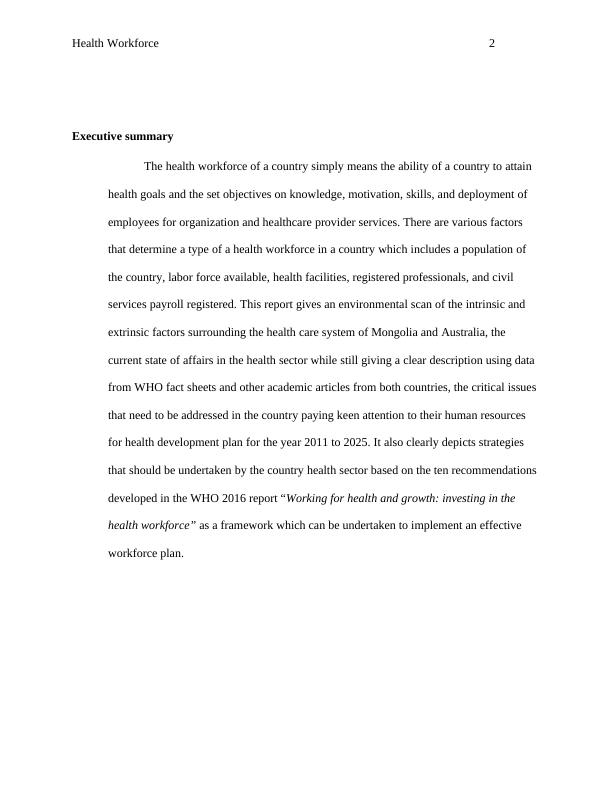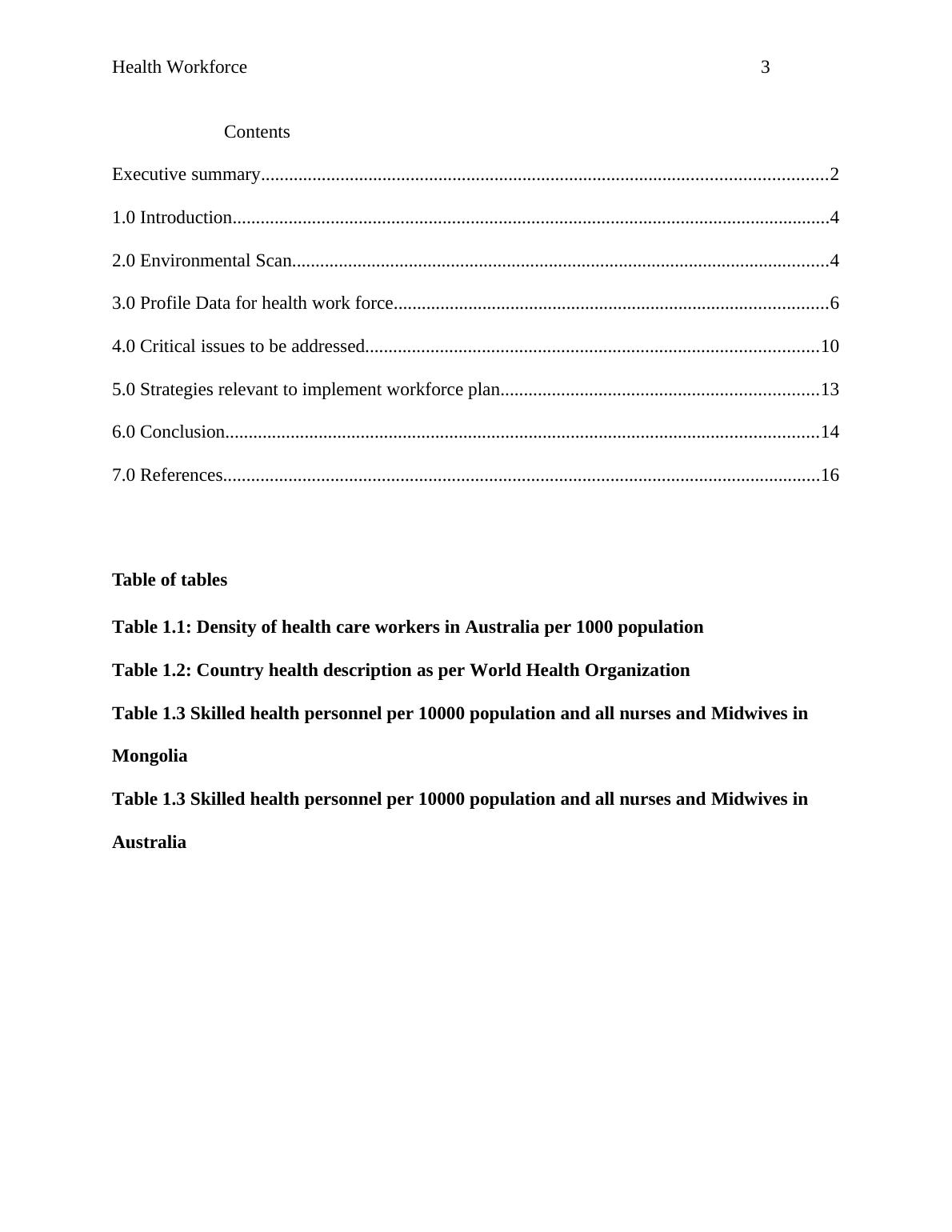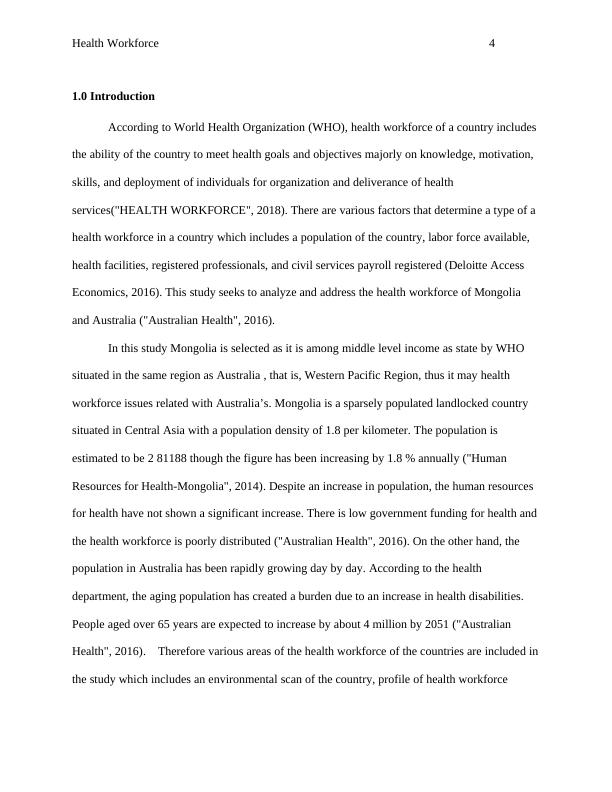Environmental Scan of the Intrinsic and Extrinsic
Added on 2021-06-15
17 Pages3670 Words21 Views
Running head: HEALTH WORKFORCE 1
Health workforce
(Author’s name)
(Institutional Affiliation)
Health workforce
(Author’s name)
(Institutional Affiliation)

Health Workforce 2
Executive summary
The health workforce of a country simply means the ability of a country to attain
health goals and the set objectives on knowledge, motivation, skills, and deployment of
employees for organization and healthcare provider services. There are various factors
that determine a type of a health workforce in a country which includes a population of
the country, labor force available, health facilities, registered professionals, and civil
services payroll registered. This report gives an environmental scan of the intrinsic and
extrinsic factors surrounding the health care system of Mongolia and Australia, the
current state of affairs in the health sector while still giving a clear description using data
from WHO fact sheets and other academic articles from both countries, the critical issues
that need to be addressed in the country paying keen attention to their human resources
for health development plan for the year 2011 to 2025. It also clearly depicts strategies
that should be undertaken by the country health sector based on the ten recommendations
developed in the WHO 2016 report “Working for health and growth: investing in the
health workforce” as a framework which can be undertaken to implement an effective
workforce plan.
Executive summary
The health workforce of a country simply means the ability of a country to attain
health goals and the set objectives on knowledge, motivation, skills, and deployment of
employees for organization and healthcare provider services. There are various factors
that determine a type of a health workforce in a country which includes a population of
the country, labor force available, health facilities, registered professionals, and civil
services payroll registered. This report gives an environmental scan of the intrinsic and
extrinsic factors surrounding the health care system of Mongolia and Australia, the
current state of affairs in the health sector while still giving a clear description using data
from WHO fact sheets and other academic articles from both countries, the critical issues
that need to be addressed in the country paying keen attention to their human resources
for health development plan for the year 2011 to 2025. It also clearly depicts strategies
that should be undertaken by the country health sector based on the ten recommendations
developed in the WHO 2016 report “Working for health and growth: investing in the
health workforce” as a framework which can be undertaken to implement an effective
workforce plan.

Health Workforce 3
Contents
Executive summary.........................................................................................................................2
1.0 Introduction................................................................................................................................4
2.0 Environmental Scan...................................................................................................................4
3.0 Profile Data for health work force.............................................................................................6
4.0 Critical issues to be addressed.................................................................................................10
5.0 Strategies relevant to implement workforce plan....................................................................13
6.0 Conclusion...............................................................................................................................14
7.0 References................................................................................................................................16
Table of tables
Table 1.1: Density of health care workers in Australia per 1000 population
Table 1.2: Country health description as per World Health Organization
Table 1.3 Skilled health personnel per 10000 population and all nurses and Midwives in
Mongolia
Table 1.3 Skilled health personnel per 10000 population and all nurses and Midwives in
Australia
Contents
Executive summary.........................................................................................................................2
1.0 Introduction................................................................................................................................4
2.0 Environmental Scan...................................................................................................................4
3.0 Profile Data for health work force.............................................................................................6
4.0 Critical issues to be addressed.................................................................................................10
5.0 Strategies relevant to implement workforce plan....................................................................13
6.0 Conclusion...............................................................................................................................14
7.0 References................................................................................................................................16
Table of tables
Table 1.1: Density of health care workers in Australia per 1000 population
Table 1.2: Country health description as per World Health Organization
Table 1.3 Skilled health personnel per 10000 population and all nurses and Midwives in
Mongolia
Table 1.3 Skilled health personnel per 10000 population and all nurses and Midwives in
Australia

Health Workforce 4
1.0 Introduction
According to World Health Organization (WHO), health workforce of a country includes
the ability of the country to meet health goals and objectives majorly on knowledge, motivation,
skills, and deployment of individuals for organization and deliverance of health
services("HEALTH WORKFORCE", 2018). There are various factors that determine a type of a
health workforce in a country which includes a population of the country, labor force available,
health facilities, registered professionals, and civil services payroll registered (Deloitte Access
Economics, 2016). This study seeks to analyze and address the health workforce of Mongolia
and Australia ("Australian Health", 2016).
In this study Mongolia is selected as it is among middle level income as state by WHO
situated in the same region as Australia , that is, Western Pacific Region, thus it may health
workforce issues related with Australia’s. Mongolia is a sparsely populated landlocked country
situated in Central Asia with a population density of 1.8 per kilometer. The population is
estimated to be 2 81188 though the figure has been increasing by 1.8 % annually ("Human
Resources for Health-Mongolia", 2014). Despite an increase in population, the human resources
for health have not shown a significant increase. There is low government funding for health and
the health workforce is poorly distributed ("Australian Health", 2016). On the other hand, the
population in Australia has been rapidly growing day by day. According to the health
department, the aging population has created a burden due to an increase in health disabilities.
People aged over 65 years are expected to increase by about 4 million by 2051 ("Australian
Health", 2016). Therefore various areas of the health workforce of the countries are included in
the study which includes an environmental scan of the country, profile of health workforce
1.0 Introduction
According to World Health Organization (WHO), health workforce of a country includes
the ability of the country to meet health goals and objectives majorly on knowledge, motivation,
skills, and deployment of individuals for organization and deliverance of health
services("HEALTH WORKFORCE", 2018). There are various factors that determine a type of a
health workforce in a country which includes a population of the country, labor force available,
health facilities, registered professionals, and civil services payroll registered (Deloitte Access
Economics, 2016). This study seeks to analyze and address the health workforce of Mongolia
and Australia ("Australian Health", 2016).
In this study Mongolia is selected as it is among middle level income as state by WHO
situated in the same region as Australia , that is, Western Pacific Region, thus it may health
workforce issues related with Australia’s. Mongolia is a sparsely populated landlocked country
situated in Central Asia with a population density of 1.8 per kilometer. The population is
estimated to be 2 81188 though the figure has been increasing by 1.8 % annually ("Human
Resources for Health-Mongolia", 2014). Despite an increase in population, the human resources
for health have not shown a significant increase. There is low government funding for health and
the health workforce is poorly distributed ("Australian Health", 2016). On the other hand, the
population in Australia has been rapidly growing day by day. According to the health
department, the aging population has created a burden due to an increase in health disabilities.
People aged over 65 years are expected to increase by about 4 million by 2051 ("Australian
Health", 2016). Therefore various areas of the health workforce of the countries are included in
the study which includes an environmental scan of the country, profile of health workforce

End of preview
Want to access all the pages? Upload your documents or become a member.
Related Documents
Health Workforce Planninglg...
|14
|2709
|321
Health Workforce Planninglg...
|15
|3916
|74
Health Workforce Planning in Indonesialg...
|14
|3372
|85
Health Work Force Planninglg...
|13
|3556
|54
Nursing Workforce in Australia: Challenges and Recommendationslg...
|14
|2512
|327
